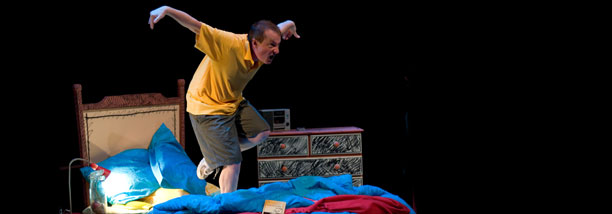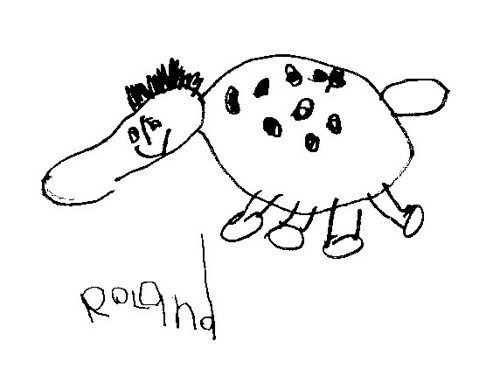
I have such a fondness for Jack. For once I don’t mean Jack, my Jack Russell terrier. I mean Jack, the charming, hilarious, resilient boy at the heart of Susanne Gervay‘s very important children’s novel, “I Am Jack”.
I was fortunate enough to be given this book to review for the teacher-librarian’s journal, Scan, in 2000. It was in a stack of about fifteen assorted new books, but it just stood out. First of all, the intriguing cover (as below) was at once bright yet ominous, and, within a few pages of reading, I was rallying to the cause of its appealing protagonist – who goes from lovable, normal, happy-go-lucky kid, to unexpected victim, to proud and empathetic victor, throughout the course of the book. The story really touched the heartstrings. It was probably no surprise, bumping into the author at a literary function some months later, that I learned how much autobiographical truth there was in “I Am Jack”. Susanne and her son, whom I also met at another function, bravely shared their true story of playground bullying so that other children might be empowered.
A few years later, in my role of editor of Scan, I worked with a school team of educators who’d used Susanne’s book with students, and wanted to share their journey and results in the journal. The Scan article went through quite a long consultative process. Crossing over several Key Learning Areas as it did, and being about such a sensitive issue as bullying, it was so important that the article – not to mention the teaching notes, and my interview with Susanne) would cross all the t’s and dot all the i’s (or is that cross all the eyes?). The article(s) eventually appeared in Scan 21(3) August 2002.
A few weeks ago, I heard that “I Am Jack” had been turned into a play for schools. By coincidence, Susanne and I had just found each other again – this time on Facebook, and she gave me some days and venues. It had already been playing relatively close by: at Parramatta, but I’d missed that. In a panic, I realised that all of these other times were for weekdays. Drat. Except today… 2pm. If I felt like getting myself to Campbelltown.
Or I could wait until its return season… Next year. D’oh!
The radio was warning about a blazing hot day but I decided that, if there was no railway track maintenance when I checked the online timetables this morning, and if I could leave it till after 10.00am before I left the house (having confirmed with the box office that there were some tickets left), then I’d venture off to the unknown wilderness that is Campbelltown to see the play.
Timing worked out perfectly. After two longish train legs, and a leisurely walk from Campbelltown Station, past lots of intriguing shops I was sure I’d never get back to, to the beautiful Arts Centre, I was there in plenty of time to have lunch!
At about 1.50 pm, I wandered over to the theatre area and there was Susanne signing copies of “I Am Jack”. It was great to see her again. Her fellow authors, Di Bates and Bill Condon, both of who I knew well from my early days as a teacher-librarian, ended up sitting next to me – another happy reunion – and I also got to meet the real “Rob”, template for fictional Jack’s gregarious and supportive future step-Dad in “I Am Jack”.
How to describe the set? It’s a one-actor tour de force, with Tim McGarry (pictured above, photo by Terry Moore) portraying Jack and ten supporting characters, surrounded by oversized, scribbled-on furniture that at once recaptures Cathy Wilcox’s unique illustrations in the book, and makes Tim McGarry the size of an eleven-year-old schoolboy!

Tim had an array of wonderful shorthand mimes to cue the audience as to which supporting character would be appearing next. Feeble Nanna playing “Uno” against Jack was a hoot, as was Rob driving the car, one hand on the wheel. Also amazing was Jack playing handball against unseen opponents, without a tennis ball being thrown.
The anti-bullying message is crystal clear, both in the book and the play: it can happen to anyone, at any time; bullies isolate someone, in order to improve their own sense of power, and they can peck away at whatever self-esteem the victim has/had until he or she is further and further isolated from the very people who could have helped; it takes the whole group to stand firm against bullying, so it’s a change of culture that will affect a change in behaviour.
The play concluded with a question-and-answer session with Tim and Susanne. Apart from some perceptive questions about bullying and writing by the young audience, a real hit, prop-wise, was Jack’s amazing science experiment: the ponto in its glass jar: an onion grafted onto a potato, which has seemingly successfully sprouted and may, one day, make Jack a fortune as an impossible hybrid plant! Amazingly, the play’s ponto was made from plastic vegetables bought from a two-dollar shop by the Monkey Baa propmaster. (You know what? I want one!)
After that, Susanne invited a group of us back to the Arts Centre’s cafe for coffee. Even though they were “closing in ten minutes”, I’m sure we got in a good twenty extra minutes of gossiping.
I had such a great day. It was well worth the long commute.
So, if you notice that “I Am Jack” is coming to a theatre near you, or if you know anyone who has ever bullied, or been bullied, this play is one to see! And, in the meantime, read the book. Or its excellent sequel, “Super Jack”.



